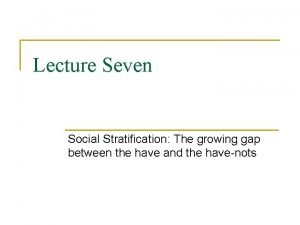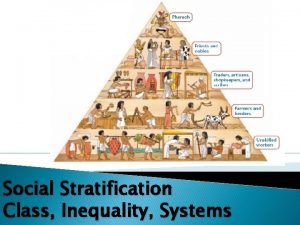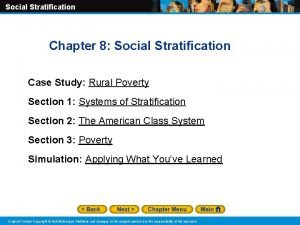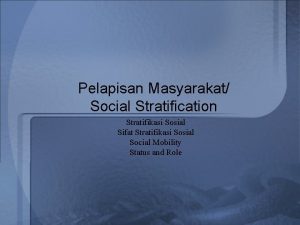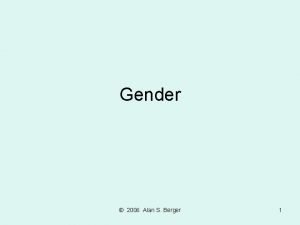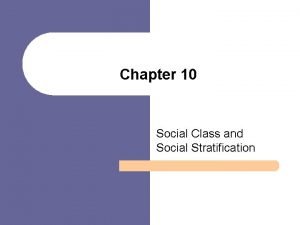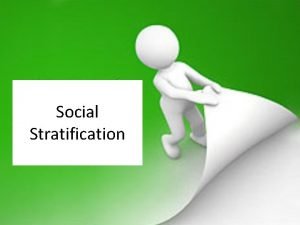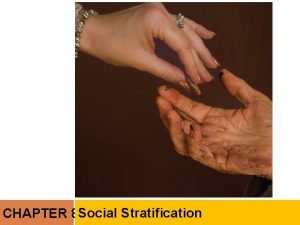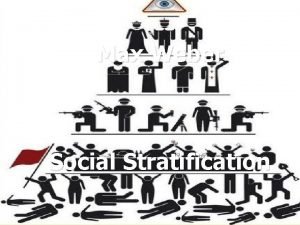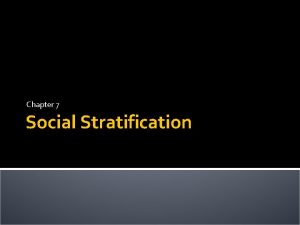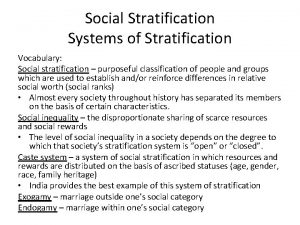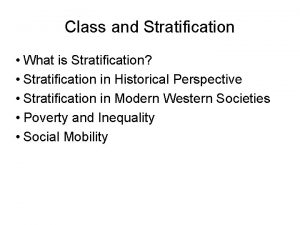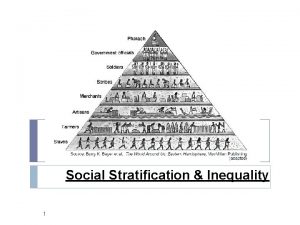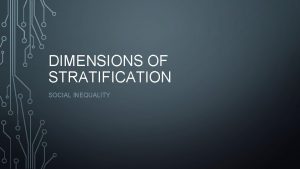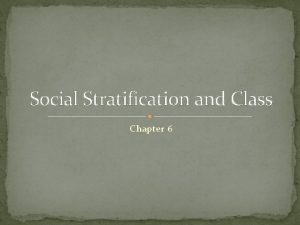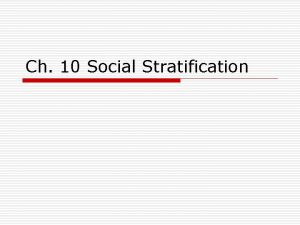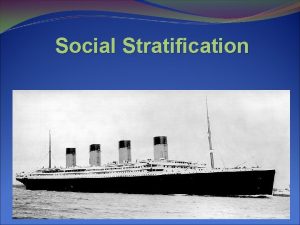SOCIAL STRATIFICATION Chapter 8 What is Social Stratification















- Slides: 15

SOCIAL STRATIFICATION Chapter 8

What is Social Stratification? � � Social stratification is the division of society into categories, ranks, or classes. These divisions lead to social inequality—the unequal sharing of resources and social rewards. Stratification systems lie on a continuum of open to closed systems according to how easy or difficult it is to change statuses. Both ascribed and achieved statuses can be used to determine social standing.

Types of Stratification Systems Caste Systems • • • Closed stratification system Resources and social rewards distributed based on ascribed statuses Lifelong status determined by that of parents Prohibits exogamy, or marriage outside of caste; promotes endogamy, or marriage within caste Caste system in India has been challenged but still plays a major role

Types of Stratification, cont’d Class Systems • Class system more open than closed stratification system • Resources and rewards distributed according to achieved statuses • Some control over place in society • Marx divided society into: • – Bourgeoisie, or the owners of the means of production – Proletariat, or workers who sell their labor in exchange for wages Weber described three factors of class: – Property – Prestige – Power

Terms for Dimensions of Social Stratification � • • Social class is a grouping of people with similar levels of wealth, power, and prestige. Wealth – Wealth equals assets—value of everything the person owns—and income —money earned through salaries, investment returns, or other capital gains Power – Power is the ability to control the behavior of others, with or without their consent – Can be based on force, a special skill or type of knowledge, particular social status, personal characteristics, or custom and tradition Prestige – Prestige is the respect, honor, recognition, or courtesy an individual receives – Occupation, education, family background, and area of residence are common factors in the United States. Socioeconomic status is a rating that combines social factors such as educational level, occupational prestige, and place of residence with the economic factor of income

Explaining Stratification Functionalist Theory: sees stratification as necessary feature • Certain roles must be performed for stability of society Conflict Theory: see competition over scarce resources as the cause • Stratification comes from class exploitation Efforts at Synthesis • Dahrendorf suggests each approach might be used to explain specific aspects of stratification • Lenski suggests each approach might be used to describe different societies

Three techniques to determining social class in the United States Reputational Method – Individuals in the community are asked to rank other members based on what they know of their characters and lifestyles – Suitable only for small communities – Cannot be used across communities Subjective Method – Individuals are asked to determine their own social rank – Most people choose middle class Objective Method – Income, occupation, and education – Statistical nature makes this method least biased – Choosing different factors brings different results

SIX Social Class in the U. S. • The Upper Class: 1 percent of population “Old money” have been rich for generations • “New money” is not as prestigious The Upper Middle Class: 14 percent of population • High-income businesspeople and professionals such as doctors and lawyers • Many are politically and socially active The Lower Middle Class: 30 percent of population • Most hold white-collar jobs that require less education and provide less income such as nursing, middle management, sales • Live a comfortable life but must work to maintain it • • The Working Class: 30 percent of population Many hold jobs that require manual labor or blue-collar jobs • Jobs may pay more, but have less prestige than white-collar Unexpected crises can push individuals into lower classes The Working Poor: 22 percent of population • Lowest-paying jobs such as housecleaning, migrant farm work, and day labor • Many rely on government programs and are high school dropouts • • The Underclass: 3 percent of population • • • Have experienced unemployment and poverty for several generations Most rely on government programs Life is a day-to-day struggle

Social Mobility • Social mobility is the movement between or within social classes. • Horizontal mobility refers to movement within a social class or stratum. • Vertical mobility refers to the movement between social classes or strata. • There are two kinds of vertical mobility: • intragenerational mobility (within a person’s lifetime) • intergenerational mobility (several generations of one family)

What are some causes of social mobility? Causes of Upward Mobility • • Individual effort Technological change Change in merchandising patterns Increase in population’s general educational level Causes of Downward Mobility • • • Personal factors such as illness, divorce, or retirement Technological change altering the demand for labor Overall economic health

Defining Poverty in the U. S. • • Although the United States is one of the richest countries in the world, about 13 percent of its population lives below the poverty line. Poverty is a standard of living that is below the minimum level considered adequate by society. What one society sees as poverty might be seen as adequate by another society. Poverty level is the minimum income needed by a family to survive, calculated as the cost of an adequate diet. Criticism of the method of calculating poverty has led to attempts to find a better definition of poverty.

U. S. Poverty

Variations in American Poverty � Not every American runs the same risk of being poor. � Characteristics such as age, sex, and race and ethnicity affect poverty. • Age – • Sex – • As an age group, children have the largest percentage in poverty About 57 percent of the poor are women Race and Ethnicity – African Americans and Hispanics are more likely than whites to live in poverty

Effects of Poverty � Life Chances � Patterns of Behavior • Life chances define the likelihood that an individual will share in the opportunities and benefits of society. Life chances include health, length of life, housing, and education. Poverty is a disadvantage in health and life expectancy. • Divorce rates are higher among low-income families. Crime rates are higher in poor communities. • • •

Government Responses to Poverty � � • • In 1964 President Lyndon Johnson declared a “war on poverty, ” and the federal government has taken an active role in attempting to reduce inequality. Transfer payments redistribute money within society by funneling a percentage of tax revenues to groups that need public assistance. In 1996 federal law turned some welfare over to the states. Those who get off welfare face difficulty feeding their families p. 201
 Social stratification vs social inequality
Social stratification vs social inequality Sociopoly
Sociopoly Chapter 8 social stratification
Chapter 8 social stratification Chapter 9 social stratification
Chapter 9 social stratification Chapter 8 social stratification
Chapter 8 social stratification Mixed social stratification
Mixed social stratification Gender stratified
Gender stratified Regular expression symbols
Regular expression symbols Global stratification definition
Global stratification definition Social stratification in sociology
Social stratification in sociology American class system
American class system Supposedly definition
Supposedly definition Max weber social class
Max weber social class Systems of social stratification
Systems of social stratification Social stratification definition
Social stratification definition Jelaskan pengertian
Jelaskan pengertian
